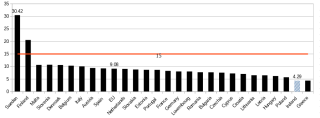Ireland must improve Sustainable Energy Sources for Transport

A recent Report from Eurostat, examines the percentage of renewable energy sources in transport in the EU 2021. The current target is 14 per cent by 2030. The 2020 target was missed by 0.9 percentage points. In 2021, 9.1 per cent level was achieved across the EU which is a fall of 1.2 percentage points on 2020. Progress across the EU is mixed with Ireland faring poorly.
All EU members recorded a decrease in 2021 apart from Finland, Lithuania, Denmark, Croatia and Malta. Between 2020 and 2021, the largest decreases in the EU were to be found in Ireland (-5.9 percentage points), Hungary (-5.4 percentage points) and Luxembourg (-4.6 percentage points). Added to this, the lowest share was also registered in Ireland and Greece, both at just about 4.3 per cent.
The report notes that whilst there has been an increase in the use of renewables, the increase in general transport activity after the lifting of Covid-19 restrictions will have impacted the overall figures.
Chart 1 shows that only two countries exceeded the 2030 target, Sweden and Finland. These high shares are as a result of 'the significant use of compliant biofuels in their transport fuel mix'. Chart 1 shows how countries fared against the 2030 goal of 15 per cent.
Chart 1: Share of energy from renewable sources in transport, EU, % by country, 2021.

Source: Eurostat, Share of energy from renewable sources, NRG_IND_REN, 2023.
Ireland's Transport Fuel Use
Transport Omnibus 2021 from the Central Statistics Office (CSO) reported the share of electric or plug-in hybrid electric vehicles (PHEVs) bought in 2021 was more than twice that of 2020, an increase from 8 per cent to 16 per cent. Private cars accounted for 72 per cent of the distance travelled in 2021, each car on average clocking up 13,436 kilometres in 2021 and the average annual vehicle kilometres travelled was greater for diesel cars when compared to petrol cars. The CSO's Transport Bulletin January 2023 reports 79 million litres of petrol clearances in November 2022 which is an 8 per cent increase on November 2021. 310 million litres autodiesel were also in November 2022, this was 0.4 per cent higher than in November 2021. [1]
The move away from fossil fuels for transport will bring the country closer to meeting climate action goals and by increasing the use of renewables, lower costs.
The Covid-19 pandemic, the climate crisis and, now, the geoeconomics crisis caused by the Russian aggression against Ukraine, has revealed a fossil-fuel based economic system that remains fundamentally unsustainable and incapable of adequately meeting the needs of all peoples.
We must increase the provision of public transport, especially in rural areas and we must provide greater investment in sustainable transport and biofuels.
[1] The CSO notes that "Statistics on the volume of fuel clearances covered by excise taxes are collected by the Revenue Commissioners. Clearances reflect the excise duties paid on oil removed from tax warehouses. This data provides a proxy for sales and the associated level of consumption, but they do not reflect actual consumption."
Source - Eurostat Statisics Explained
"Renewable energy sources, also called renewables, are energy sources that replenish (or renew) themselves naturally. Typical examples are solar energy, wind and biomass.
Renewable energy sources in energy statistics include the following:
- Non-combustible renewables
- Hydropower: the electricity generated from the potential and kinetic energy of water in hydroelectric plants (the electricity generated in pumped storage plants is not included);
- Tide, wave, ocean energy: mechanical energy derived from tidal movement, wave motion or ocean current and exploited for electricity generation
- Geothermal energy: the energy available as heat from within the earth’s crust, usually in the form of hot water or steam;
- Wind energy: the kinetic energy of wind converted into electricity in wind turbines;
- Solar energy: solar thermal energy (radiation exploited for solar heat) and solar photo-voltaic for electricity production.
- Ambient heat (heat pumps): heat pumps that are driven by electricity or other supplementary energy, to extract (stored) energy from the air, the ground or the water and converts/transfers this into energy to be used elsewhere (e.g. to heat space via underfloor heating systems and/or water in domestic buildings). Heat pumps can be used by individual households as well as at larger scale in industry and in commercial and public services. Energy flows related to heat pumps used for cooling are excluded, only heat pumps used for heating (hot water) are included.
- Combustible renewables
- Biofuels: fuels from biomass; includes solid biofuels, biogas and liquid biofuels
- Renewable municipal waste"